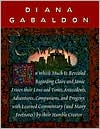The Sorcerer's Companion: A Guide to the Magical World of Harry Potter
The New York Times bestseller, now fully updated to include the complete seven-volume series.\ Who was the real Nicholas Flamel? How did the Sorcerer’s Stone get its power? Did J. K. Rowling dream up the terrifying basilisk, the seductive veela, or the vicious grindylow? And if she didn’t, who did?\ Millions of readers around the world have been enchanted by the magical world of wizardry, spells, and mythical beasts inhabited by Harry Potter and his friends. But what most readers don’t know...
Search in google:
The New York Times bestseller, now fully updated to include the complete seven-volume series.Who was the real Nicholas Flamel? How did the Sorcerer’s Stone get its power? Did J. K. Rowling dream up the terrifying basilisk, the seductive veela, or the vicious grindylow? And if she didn't, who did?Millions of readers around the world have been enchanted by the magical world of wizardry, spells, and mythical beasts inhabited by Harry Potter and his friends. But what most readers don’t know is that there is a centuries-old trove of true history, folklore, and mythology behind Harry’s fantastic universe. Now, with The Sorcerer’s Companion, those without access to the Hogwarts Library can school themselves in the fascinating reality behind J. K. Rowling’s world of magic. Newly updated to include Harry Potter and the Half Blood Prince, and Harry Potter and the Deathly Hallows, The Sorcerer’s Companion allows curious readers to look up anything magical from the Harry Potter books and discover a wealth of entertaining, unexpected information. Wands and wizards, boggarts and broomsticks, hippogriffs and herbology, all have astonishing histories rooted in legend, literature, or real-life events dating back hundreds or even thousands of years. Magic wands, like those sold in Rowling’s Diagon Alley, were once fashioned by Druid sorcerers out of their sacred yew trees. Love potions were first concocted in ancient Greece and Egypt. And books of spells and curses were highly popular during the Middle Ages. From Amulets to Zombies, you'll also learn:• how to read tea leaves • where to find a basilisk today • how King Frederick II of Denmark financed a war with a unicorn horn • who the real Merlin was • how to safely harvest mandrake root • who wore the first invisibility cloak• how to get rid of a goblin • why owls were feared in the ancient world• what really lies beyond the Veil• the origins of our modern-day “bogeyman,” and more. A spellbinding tour of Harry’s captivating world, The Sorcerer’s Companion is a must for every Potter aficionado’s bookshelf.The Sorcerer's Companion has not been prepared, approved, or licensed by any person or entity that created, published, or produced the Harry Potter books or related properties.Publishers WeeklyFather/daughter team Allan Zola Kronzek and Elizabeth Kronzek target the wizard's mature fans with The Sorcerer's Companion: A Guide to the Magical World of Harry Potter. Each alphabetically organized entry contains a potent blend of fact, fiction and folklore. The "Broomstick" entry, for instance, details the effects of a purported "flying ointment" that witches rub into their brooms to prepare for takeoff. The section on "The Sorcerer's Stone" explains the ancient Egyptian art of alchemy. A note at the end of each section shows readers where to find the reference in the Harry Potter books. Thorough research and period prints combine to create a memorable book.
The Sorcerer's Companion\ A Guide to the Magical World of Harry Potter, Third Edition \ \ By Allan Zola Kronzek \ Broadway\ Copyright © 2010 Allan Zola Kronzek\ All right reserved.\ ISBN: 9780307885135 \ \ \ If you're like most Harry Potter fans, you probably know that Harry's prized possession is his broomstick, Hermione's favorite subject is arithmancy, and a magnificent creature called a hipogriff helped Sirius Black evade capture. But did you know that wizards were once thought to fly on pitchfoks, arithmancy is an ancient form of fortune-telling, and the hippogriff was first mounted by the legendary knights of Charlemagne? Or that Professor Dumbledore's friend Nicholas Flamel, creator of the Sorcerer's stone, was a real person?\ \ So quickly do the astonishing adventures of Harry and his friends fly by that we rarely have a moment to consider the wealth of real mythology, folklore, and history that shimmers just beneath the surface. One of the great pleasures of reading the Harry Potter books comes from the extraordinary richness of the magical universe they contain--fashioned partly from J.K. Rowling's seemingly boundless imagination and partly from the vast collective lore of magic from around the world. Potions and charms, giants and dragons, cauldrons and crystal balls--all have intriguing and often surprising histories going back hundreds and sometimes thousands of years. Magic wands like those sold in Diagon Alley were once fashoned by Druid sorcerers out of the sacred yew tree. Love potions are traceable to ancient Greece and Rome. And books of spells and curses--required reading at Hogwarts School of Witchcraft and Wizardry--were highly popular (and much frowned upon) during the Middle Ages.\ \ The Sorcerer's Companion allows the curious reader to look up anything "magical" from any of the first four Harry Potter books and discover a wealth of fascinating and unexpected information. How did the Sorcerer's Stone get its power? What were the first magic words? Did J.K. Rowling dream up the terrifying basilisk, the seductive veela, or the vicious grindylow? And if she didn't, who did? The Sorcerer's Companion has the answers. \ \ The history of magical beliefs is vast, and in writing this book we had to leave out far more than we put in. Barely mentioned are the rich traditions of magic and mythology of China, Africa, India, Japan, Australia, and South America. Rather we have limited our focus to those aspects of lore directly related to Harry's world. Nearly all of the magical practices at Hogwarts are rooted in the Western magical tradition, which emerged from the ancient empires of the Middle East, Greece, and Rome. Imaginary creatures like the centaur, the manticore, and the unicorn come from the same rich tradition. Many other magical beings, such as elves, gnomes, goblins, hinkypunks, and trolls, have their roots in the folklore of northern Europe and the British Isles.\ \ When we first began writing The Sorcerer's Companion we asked Harry Potter fans what subjects interested them the most. Some wanted to know more about spells, charms, and curses. Others were eager to learn about boggarts, red caps, or the difference between witches and hags. We expect you, too, will have your own particular interests and will follow them as you choose. This book is not intended to be read straight through in alphabetical order, although it certainly can be. You might want to start with the Magic entry for an introduction to this fascinating subject. But you can actually start anywhere--and chances are, you'll end up everywhere. \ \ In each entry, we've tried to provide an overview of the subject and its roots in mythology, folklore, and history. Whenever a word appears in bold, that means it has its own entry. Following most entries, you'll find a symbol and an abbreviation indicating one place in the Harry Potter books where the subject appears. "SS 5/71," for example, refers you to Harry Potter and the Sorcer's Stone, chapter 5, page 71. CS refers to Harry Potter and the Chamber of Secrets, PA refers to Harry Potter and the Prisoner of Azkaban, and GF refers to Harry Potter and the Goblet of Fire. All references are to the American editions. \ \ In researching The Sorcerer's Companion we learned many curious things we never expected to know, like how to read tea leaves, get rid of goblins, safely harvest mandrake root, and use arithmancy to choose a breakfast cereal. We feel more secure knowing how to recognize a demon and what to do if attacked by a ghoul (never, ever hit him twice). We hope all of this information is as interesting to you as it is to us. You might never know when you might need it.\ \ Amulet\ \ Are you unusually susceptible to colds and infections? Do you have a tendency to attract the wrong kind of attention? Are you plagued by bad luck? If the answer to any of these questions is yes, an amulet might be just what the doctor ordered. In fact, centuries ago, an amulet was what the doctor ordered--to ward off disease, avoid misfortune, or chase away evil spirits.\ \ An amulet (from the Latin word amuletum, meaning "a method of defense") is an object thought to magically protect its owner from harm. Amulets can come in any size, shape, or material. Indeed, when Hogwarts is struck by a mysterious epidemic of petrification, Neville Longbottom tries to protect himself with an amulet made from a smelly green onion! amulets range from small pendants, rings, and pouches of herbs (worn around the neck to prevent disease) to sizable statues and wall hangings intended to protect the entire household, building, or village. The ancient Babylonians liked to wear tiny, jewel-encrusted clay cylinders to ward off evil spirits. The Romans collected sculptures of Priapus, the god of luck and fertility, and many Americans still hang lucky horseshoes over their doors to guard against misfortune and unwelcome visitors.\ \ Amulets have been present in virtually every society since the beginning of recorded history. The earliest amulets were probably just chunks of stone or metal whose bright colors or unusual shapes suggested they might have magical properties. (In India and Thailand, pieces of pink coral are still used to ward off the evil eye.) Over time, however, it became customary to make amulets in the shape of animals, god and goddess figures, and magic symbols. Images of horns and hands (symbolizing fertility and life) and drawings or carvings of the human eye (suggesting eternal watchfulness) appear on amulets throughout the world. Many amulets also have magic words, short spells, or the names of gods written on them. \ \ Although their appeal is nearly universal, amulets are most closely associated with the ancient Egyptians, who wore them everywhere--even to the grave. It was customary for mummies to be buried with dozens of beetle-shaped amulets called scarabs. These small stone figurines, named after a real type of Egyptian beetle, were supposed to prevent the deceased person's soul from being eaten by Ammit the Devourer--a dreadful part-lion, part-hippo, part-crocodile who guarded scales of justice in the Egyptian afterworld. Apparently, the more important a person was, the more scarabs he took to the afterworld. When King Tutankhamen's body was unearthed some eighty years ago, over 140 amulets were found tucked away in the wrappings of his mummy! Other common Egyptian amulets like the ankh (an Egyptian hieroglyph symbolizing life) and the wadjet (commonly known as the Eye of Horus) served more practical purposes: protecting living Egyptians from death, disease, and the evil eye. \ \ Unfortunately, amulets do have their limitations. For instance, they can only protect you from specific dangers for which they are designed. A scarab may scare Ammit the Devourer, but it's useless against vampires, hinkypunks, and treasure-hungry archaeologists. And if you're going to do battle with the forces of evil, it's important not to confuse amulets with their close cousins, talismans. Unlike enchanted swords, invisibility cloaks, and other classic talismans, amulets do not endow their owners with magical abilities. An amulet cannot be used as a weapon, only as a shield. So if you're planning some epic adventure--like slaying a dragon--you should probably swap your lucky rabbit's foot for the sword of Sir Godric Gryffindor. But if you prefer to stay home where it's nice and cozy, nothing beats an amulet for keeping hostile forces at bay. \ \ CS 11/185 \ \ Continues... \ \ \ \ Excerpted from The Sorcerer's Companion by Allan Zola Kronzek Copyright © 2010 by Allan Zola Kronzek. Excerpted by permission.\ All rights reserved. No part of this excerpt may be reproduced or reprinted without permission in writing from the publisher.\ Excerpts are provided by Dial-A-Book Inc. solely for the personal use of visitors to this web site. \ \
IntroductionxiiiAmulet: The Evil Eye1Arithmancy4Astrology: Disaster and Disease10The Zodiac15The Meaning of the Planets18Banshee19Basilisk: The Basilisk Today21Boggart: The Bogeyman24Broomstick26Cat: Cat Tales28Cauldron32Centaur35Charm: "Charmed, I'm Sure"36Circe39Crystal Ball41Curse: Licensed to Curse44The Mummy's Curse47Dark Arts48Demon: How to Recognize a Demon52Divination: The Mantic Arts56A Brief History of Tarot63Dragons: Dragons of the East65Dreams68Dwarf71Elf: The Elf's New Clothes73Fairy: The Tooth Fairy76The Cottingley Fairies79Fairy Rings81Flying Carpet82Forbidden Forest84Ghost85Ghoul89Giant90Gnome93Goblin94Grim96Grindylow98Hag100Herbology102Hex105Hinkypunk107Hippogriff: Animals on Trial108Horoscope111Invisibility Cloak113Kappa116Leprechaun: The Farmer and the Leprechaun117Magic120Magician132Magic Mirror: Mirror Superstitions145Magic Wand: The Magic Club149The Caduceus153Magic Words: A Little Hocus Pocus157Mandrake: Mandrake Safety159Manticore162Merlin164Mermaid/Merman: Mermaid Relatives168Morgana: The Fata Morgana172Mummy175Nicholas Flamel177Owl181Palmistry182Petrification186Phoenix188Pixie190Poltergeist191Potion194Red Cap197Runes: Rune Casting198Salamander200Sibyl203Snake205Sorcerer208Sorcerer's Stone: The Making of the Stone210The Faking of the Stone215Spell217Sphinx219Talisman221Tea-Leaf Reading224Three-Beaded Dog230Toad: Toadstones232Transfiguration235Troll239Unicorn: Hornswoggled242Vampire246Veela249Werewolf: "Real" Werewolves250Witch: The Witch's Familiar254Witch Persecution: Why Were Witches Women?259Wizard265Yeti268Zombie270Acknowledgments273Bibliography275Illustration Credits281
\ Publishers WeeklyFather/daughter team Allan Zola Kronzek and Elizabeth Kronzek target the wizard's mature fans with The Sorcerer's Companion: A Guide to the Magical World of Harry Potter. Each alphabetically organized entry contains a potent blend of fact, fiction and folklore. The "Broomstick" entry, for instance, details the effects of a purported "flying ointment" that witches rub into their brooms to prepare for takeoff. The section on "The Sorcerer's Stone" explains the ancient Egyptian art of alchemy. A note at the end of each section shows readers where to find the reference in the Harry Potter books. Thorough research and period prints combine to create a memorable book.\ \ \ \ \ Publishers WeeklyFather/daughter team Allan Zola Kronzek and Elizabeth Kronzek target the wizard's mature fans with The Sorcerer's Companion: A Guide to the Magical World of Harry Potter. Each alphabetically organized entry contains a potent blend of fact, fiction and folklore. The "Broomstick" entry, for instance, details the effects of a purported "flying ointment" that witches rub into their brooms to prepare for takeoff. The section on "The Sorcerer's Stone" explains the ancient Egyptian art of alchemy. A note at the end of each section shows readers where to find the reference in the Harry Potter books. Thorough research and period prints combine to create a memorable book. (Sept.) Copyright 2001 Cahners Business Information.\ \ \ VOYAThis literary guide explores the history behind all of the fantastic and mystical elements mentioned in the four Harry Potter novels. Alphabetical and encyclopedic in its design, it should be browsed randomly, rather than read straight through. Typical entries include objects (talismans and charms), lots of magic (hexes, curses, spells, and potions), crafts (astrology, rune casting, palmistry), and a full zoo of creatures (dragons, giants, grindylows, balilisks, and veelas). These features only scratch the surface of what is covered in the book. All subjects are briefly compared and contrasted as the history of each is traced. Helpful to Potter-philes is a code at the end of each entry that directs the reader to the particular Rowling novel and exact page number wherein the subject is mentioned. The elder Kronzek in this father/daughter team is a frequent lecturer on the elementary school circuit, and together they produce an attractive text, easily accessible to the young reader. The layout of the book is enhanced with illustrations and woodcuts, many dating back to sixteenth-century works. Its bibliography is equally impressive, citing more than one hundred sources from historical to Web based. The guide is an entertaining overview of European lore and mythology. One cannot help but appreciate the extensive research that J. K. Rowling delved into to incorporate such a variety of creatures and crafts into her work. Some parents, however, might have reservations about the easy manner in which this book instructs and perhaps legitimizes some of the crafts it explores, such as reading tea leaves, doing numerology, and casting spells. Nevertheless this book is a match for circulatingcollections in which the Potter books are popular. Illus. Biblio. VOYA CODES: 4Q 4P M J S (Better than most, marred only by occasional lapses; Broad general YA appeal; Middle School, defined as grades 6 to 8; Junior High, defined as grades 7 to 9; Senior High, defined as grades 10 to 12). 2001, Broadway Press, 286p, $15 Trade pb. Ages 11 to 18. Reviewer: Kevin Beach SOURCE: VOYA, February 2002 (Vol. 24, No.6)\ \ \ \ \ School Library JournalGr 4 Up-Anyone who thinks that grims, grindylows, hinkypunks, and hippogriffs were invented by J. K. Rowling will be surprised by this offering. Each of the 84 alphabetical entries describes a subject studied (arithmancy, divination), an object used (wand, cauldron), or a creature that appears in at least one of the Potter books, including a specific reference to the title, chapter, and page number. Then, using references from ancient, medieval, and modern literature, legend, mythology, and religion (almost 100 sources are listed in the extensive bibliography), each entry goes on to describe where, when, and how that subject, object, or creature has also been part of Western history, literature, or oral tradition. Most entries are from one to three pages long, with some notable exceptions-12 pages on magic and 14 on magicians throughout history. A fascinating history of the uses and abuses of medieval alchemy is buried within the article on the sorcerer's stone, but most subjects are easy to find. Sidebars highlight specific aspects in detail-the mummy's curse, alchemical frauds, animals on trial. More than half of the entries are illustrated with black-and-white drawings, woodcuts, or reproductions. The material is interesting and informative, easy to read, and fairly wide-ranging. The same readers who can't get enough of Harry Potter will enjoy learning about arithmancy, spell casting, and much more here, while waiting anxiously for the next Rowling novel to appear.-Susan L. Rogers, Chestnut Hill Academy, PA Copyright 2001 Cahners Business Information.\ \







